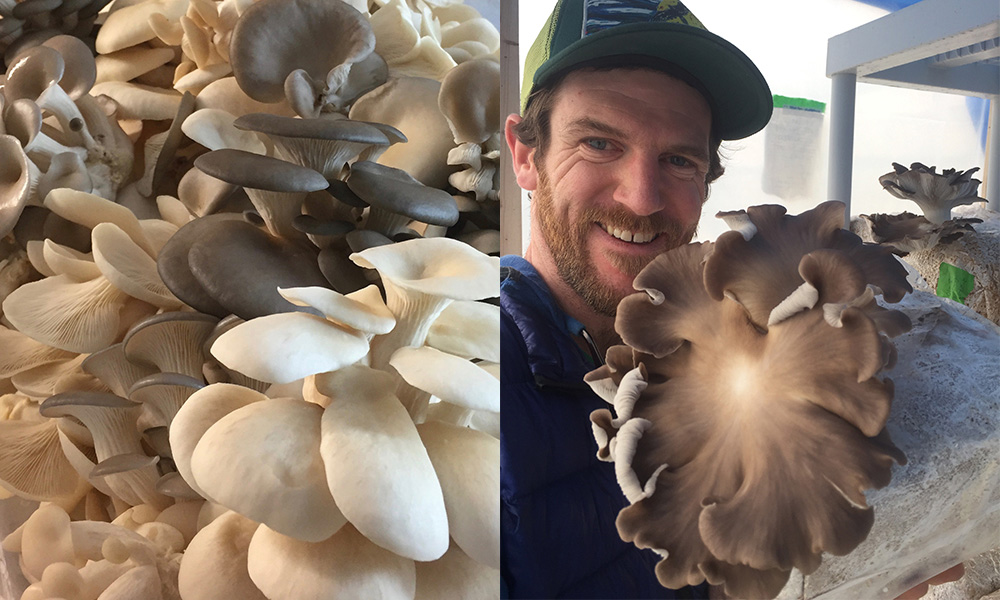Growing Edible Mushrooms Using Food Waste
Jun. 24th 2020To help divert organic materials away from landfills, Vermont’s Universal Recycling Law, Act 148, bans food scraps from landfills starting July 1, 2020. Food waste can be composted by residents at home or taken to compost facilities throughout the state. As an alternative to composting, food scraps can also be combined with dairy manure and broken down by microorganisms in the oxygen-free environment of an anaerobic digester. Anaerobic digestion produces biogas, a clean, renewable source of energy. Fifteen anaerobic digesters currently operate in Vermont.
Along with biogas, anaerobic digestion produces liquid and solid digestates, the materials remaining after digestion. Farmers commonly use the liquids to fertilize agricultural soils and the solids for animal bedding, which is eventually redigested and converted to liquid fertilizer. Unfortunately, repeated spreading of liquid digestate over time can potentially raise nutrients to excessive levels in soil. The excess nutrients can then run off into streams and lakes and cause eutrophication of surface waters and production of toxic cyanobacterial blooms.
Researchers at the University of Vermont (UVM) experimented with an alternative strategy to divert nutrients from farmland and incorporate them into valuable food products. Brendan O’Brien and Eric Roy of the UVM Rubenstein School of Environment and Natural Resources tested the use of solid digestate to grow edible mushrooms. The two scientists teamed up with experts at two New England mushroom-producing companies and added solid digestate, from the co-digestion of dairy manure and food waste, as an ingredient to the substrate on which cultivated mushrooms grow.
The research team cultivated Pleurotus ostreatus, the oyster mushroom, one of the easiest and most cost-effective species to produce. A rich source of carbohydrates, minerals, vitamins and vegetarian protein, the mushroom of the genus Pleurotus is the second most widely cultivated edible fungus in the world. The large, cream-colored to brown, shelf-like clusters of the mushroom usually grow on dead hardwood trees and logs in the forest. The fungus breaks down, or rots, the cellulose and lignin tissues in wood and thus, can be easily grown on sawdust blended with nutrient-rich materials.
O’Brien and Roy used solid digestate from two dairy manure anaerobic digesters in New England. They investigated how well different concentrations of digestates from dairy manure or both manure and food waste worked with traditional ingredients (sawdust and hulls from soybeans) to grow oyster mushrooms at UVM and at a mushroom growing facility in New Hampshire.
The researchers showed that both the dairy manure-only digestate and the manure plus food waste digestate ingredients can be used in combination with sawdust and soyhulls to produce mushroom yields comparable to commercial recipes using sawdust and soyhulls alone. This strategy could help to replace non-local substrate ingredients, such as soyhulls, in mushroom cultivation. On a dry matter basis, concentrations of 15% of each digestate in the substrate recipes in combination with 35% soyhulls and 50% sawdust yielded the same weight of mushrooms as did the traditional 1:1 soyhull to sawdust substrate recipe.
The researchers found the chemical composition of the oyster mushrooms produced on the test substrates to be safe for human consumption based on safety standards set by the U.S. Food and Nutrition Board.
“Using solids produced from anaerobic co-digestion of dairy manure and food waste to grow mushrooms helps to divert digestate nutrients away from land and into safe, protein-rich food,” said O’Brien.
“This approach represents an ‘upcycling’ of excess ‘waste’ nutrients to create valuable products and is one of several different strategies we are testing in the Nutrient Cycling and Ecological Design Lab at UVM,” said Dr. Roy, a finalist in the Vermont Phosphorus Innovation Challenge to develop technologies to separate and extract phosphorus from the state’s waste streams.
The mushroom cultivation process also produces “spent mushroom substrate” often regarded as a waste product. O’Brien and Roy found that the spent mushroom substrate from their oyster mushroom cultivation had properties that could likely support both soil health and fertility. In addition to a soil amendment, the spent mushroom substrate may also be recycled as a composting ingredient or digester feedstock. Further research is needed to better understand the potential value of spent mushroom substrate.
Solid digestates produced from anaerobic co-digestion of dairy manure and food waste can be used in mushroom farming to recycle nutrients back into the food system. Commercial oyster mushroom growers can offset non-local nitrogen supplements, such as pelleted soyhulls, in sawdust-based recipes with solid digestate amounts of approximately 15% dry matter, especially in settings where digestate solids are readily available and cost less than imported ingredients. O’Brien and Roy recommend that mushroom growers continue to experiment with digestate materials in a variety of substrate combinations and to test their use for cultivation of other high-value mushroom species.
This research was supported by Casella Waste Systems, Inc.
 ecoNEWS VT
ecoNEWS VT